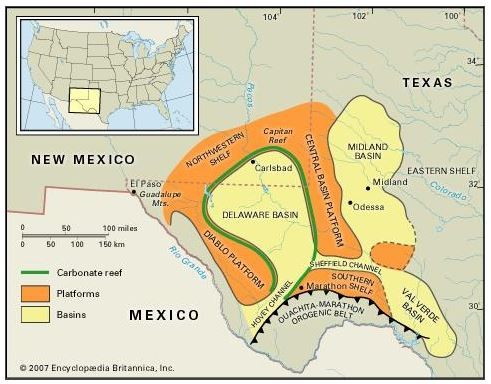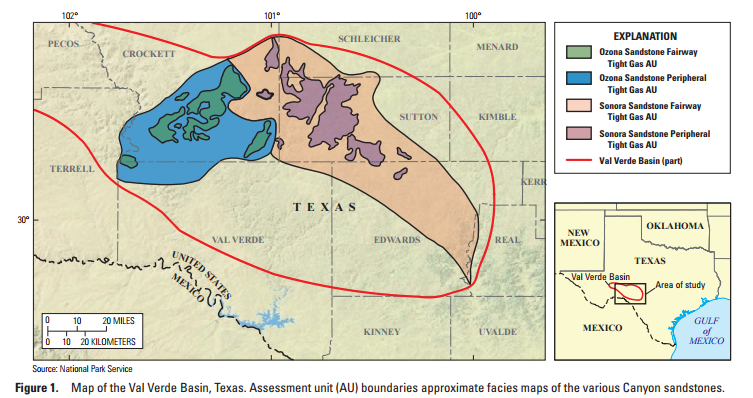New Val Verde basin assessment adds gas to Texas’s overall resources
Texas added 5 trillion cubic feet of natural gas to its reserves courtesy of a new report from the U.S. Geological Survey.
The U.S.G.S. said that its geology-based assessment methodology pegs the resources in place in the Val Verde Basin at 5 Tcf of tight gas and 187 MMBO of natural gas liquids in tight-gas assessment units in the Canyon sandstones.
On the map, the Val Verde is located southeast of the Midland basin.
Approximately 15,000 wells have already been drilled and tested in the Val Verde, helping to delineate fairways in the basin, according to the USGS. Increased development and investment in the state’s smaller plays (including the Val Verde) resulted in a 10% increase in the state’s proven reserves, and is expected to continue contributing to the state’s net total reserves.
A 2009 abstract by the University of Texas’s Bureau of Economic Gelogy defines characteristics of the Val Verde’s Ozona sandstone:
“Principal Ozona sandstone depositional systems are turbidite channel-lobe complexes arranged in point- and line-sourced, onlap-offlap aprons at the base of the north slope of the synorogenic Val Verde foreland basin. Channel and lobe genetic facies are distinguished by sandstone geometries and continuities and internal bedding styles. Turbidite sandstones are concentrated along axes of maximum subsidence that coincide with syndepositional foredeeps. Northward foredeep migration through time provides a predictive tool for locating similar sandstone maxima in underlying Canyon intervals.”
Majors have a history in the Val Verde
The Val Verde is home to several major operators, including ConocoPhillips (ticker: COP), Devon Energy (ticker: DVN) and Occidental Petroleum (ticker: OXY). The basin currently hosts 236 producing leases, 27 producing operators. The Val Verde produced 514 MMcf in February 2016, according to Texas Drilling.
Some of the earlier history of operations in the Val Verde basin were summarized in an abstract by Conoco, Inc. in 1998:
“The Val Verde Basin is a southern extension of the Delaware Basin of West Texas that was converted to a foreland trough during the Late Paleozoic Ouachita collision. This gas-rich basin has historically been known for several multiple-TCF Ellenburger fields trapped in large anticlinal structures. Despite such large reserves, the Val Verde Basin remained underexplored and poorly understood through the 1980s, owing to geologic complexity and seismic imaging problems.
“In 1989, successful application of 2-D swath seismic techniques resulted in dramatic improvements in seismic data quality and opened a new phase of exploration in the basin. In 1993, a commercial new field discovery was made in a Pennsylvanian Strawn carbonate reservoir within the thrusted foreland section. Continued exploration and development of the thrusted foreland trend, using 2-D swath and 3-D seismic, led to significant discoveries in a new play: the Thrusted “Penn” Sands.
“Conoco and its partners have drilled a total of 45 exploration and development wells in the thrusted foreland trend, and made eight new field discoveries.
“Gross daily production from these fields averages 65 MMCFD and 2100 BOPD. Structural compartmentalization, stratigraphic variability, diagenesis, and fracturing have created a complex reservoir system. Reservoir quality and quantity are the critical uncertainties.
“Early in the play, the per well commercial success rate was only about 40%. Successful field development has required the collection and integration of significant amounts of geologic, geophysical, and engineering data. Interpretation of 3-D seismic data, conventional log and image data, core data, and pressure data by a multidiscipline asset team has provided the framework for understanding the depositional and structural complexities of the thrusted foreland reservoirs. As a result, our full-cycle commercial success rate has improved to greater than 70%.”




